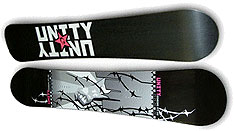Learn more about
 To Buy or Not to Buy
To Buy or Not to Buy
 From head to toes
From head to toes
 Ski Boot Fitting in 10 Steps
Ski Boot Fitting in 10 Steps
 Les Fixations de Skis
Les Fixations de Skis
 Ski F.A.Q.
Ski F.A.Q.
 Ski Equipment Care
Ski Equipment Care
 Snowboard Types
Snowboard Types
 Lebanon Skis Green not White
Lebanon Skis Green not White
 Buying a snowboard is not as easy as it once was. As the sport has developed, there are more options, including freestyle/twin-tip boards, big mountain or freeriding boards, alpine/race boards, women's boards, and children's boards.
Buying a snowboard is not as easy as it once was. As the sport has developed, there are more options, including freestyle/twin-tip boards, big mountain or freeriding boards, alpine/race boards, women's boards, and children's boards.All this segmentation is actually a good thing because you can get a board that more closely matches your needs. All you have to do is to determine what kind of riding you want to do.
Freestyle boards also are called twin-tip because they have the same dimensions on both ends and can go backward or forward. They're a good choice if you do most of your riding in terrain parks or doing jumps and tricks.
While freeride boards can be ridden fakie (backward), they're designed to go forward. Freeride boards have distinct tip and tail designs. They're a bit stiffer than freestyle boards, but not as stiff as Alpine boards, which are better for advanced riders who have mastered the carve. Alpine boards also are used with plate bindings and hard boots.
 Freestyle and freeride boards are the most versatile, best for those who like to ride all over the mountain.
Freestyle and freeride boards are the most versatile, best for those who like to ride all over the mountain.Don't buy a board that is too short. It will feel slow and you won't have as much control because of the lack of edge. Get a board that is at least as high as your chin, but not higher than you! Width also is important. Choose a board that is just about as wide as your feet are long. If your toes hang over the edge, they'll catch on the snow when you turn. And if they're too far back from the edge, you won't have enough leverage to turn well.
If you're just starting, a soft-flexing board is better. Softer flexes twist easier for smaller, lighter, or less advanced riders. A board with a deeper sidecut is also easier to turn. If you plan to just carve and ride fast, a stiffer board provides stability. Stance angle is important and instructors recommend a slightly forward-angled stance for beginners.
Height, weight, and type of riding all relate to what board you should buy. Try to find a good snowboard shop where an experienced rider can help you with your buying decision. You can find a list of shops near you from in our Gear section. If you'd like to see boards from different companies, check the Web sites of companies in our snowboard equipment listing.





